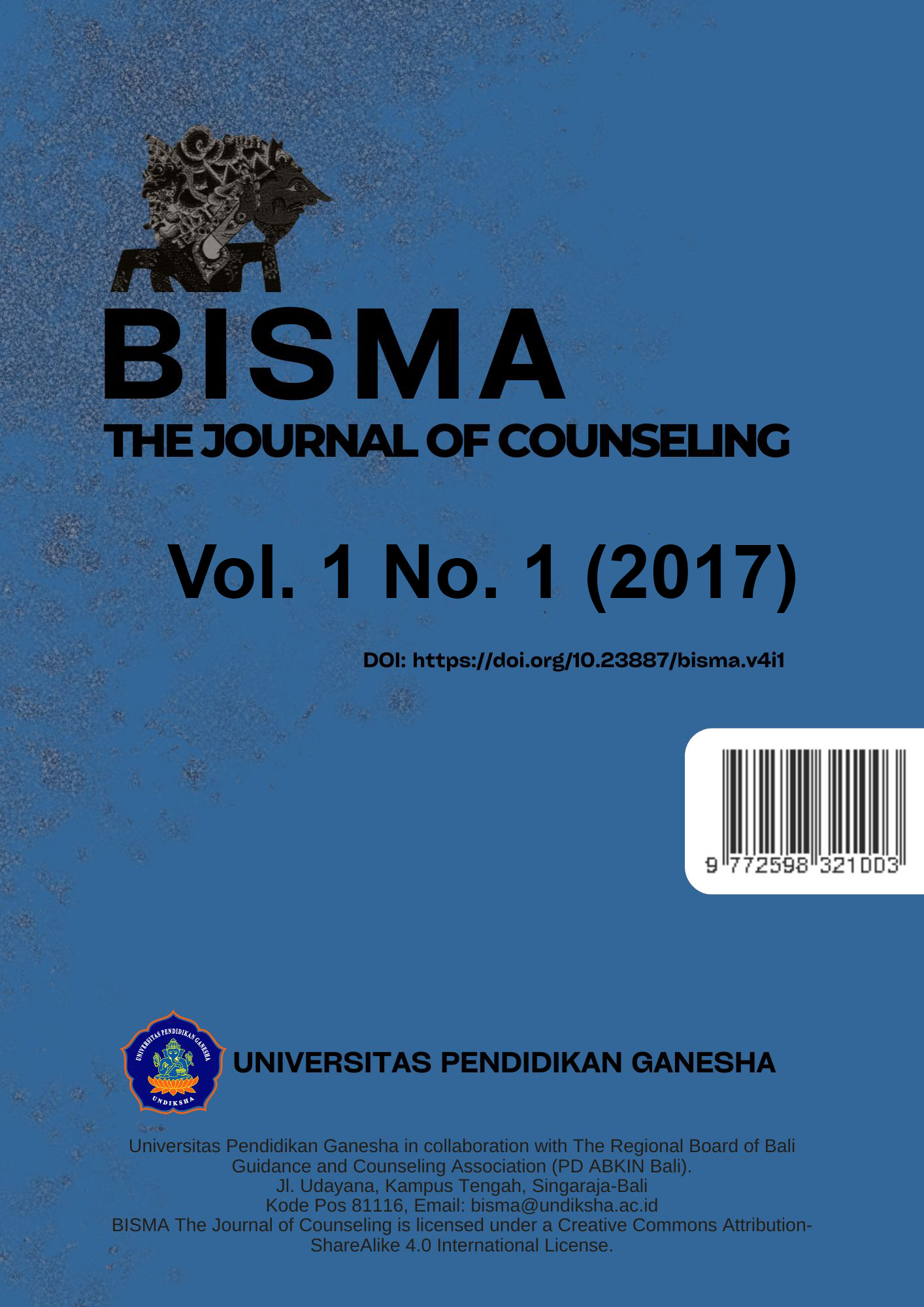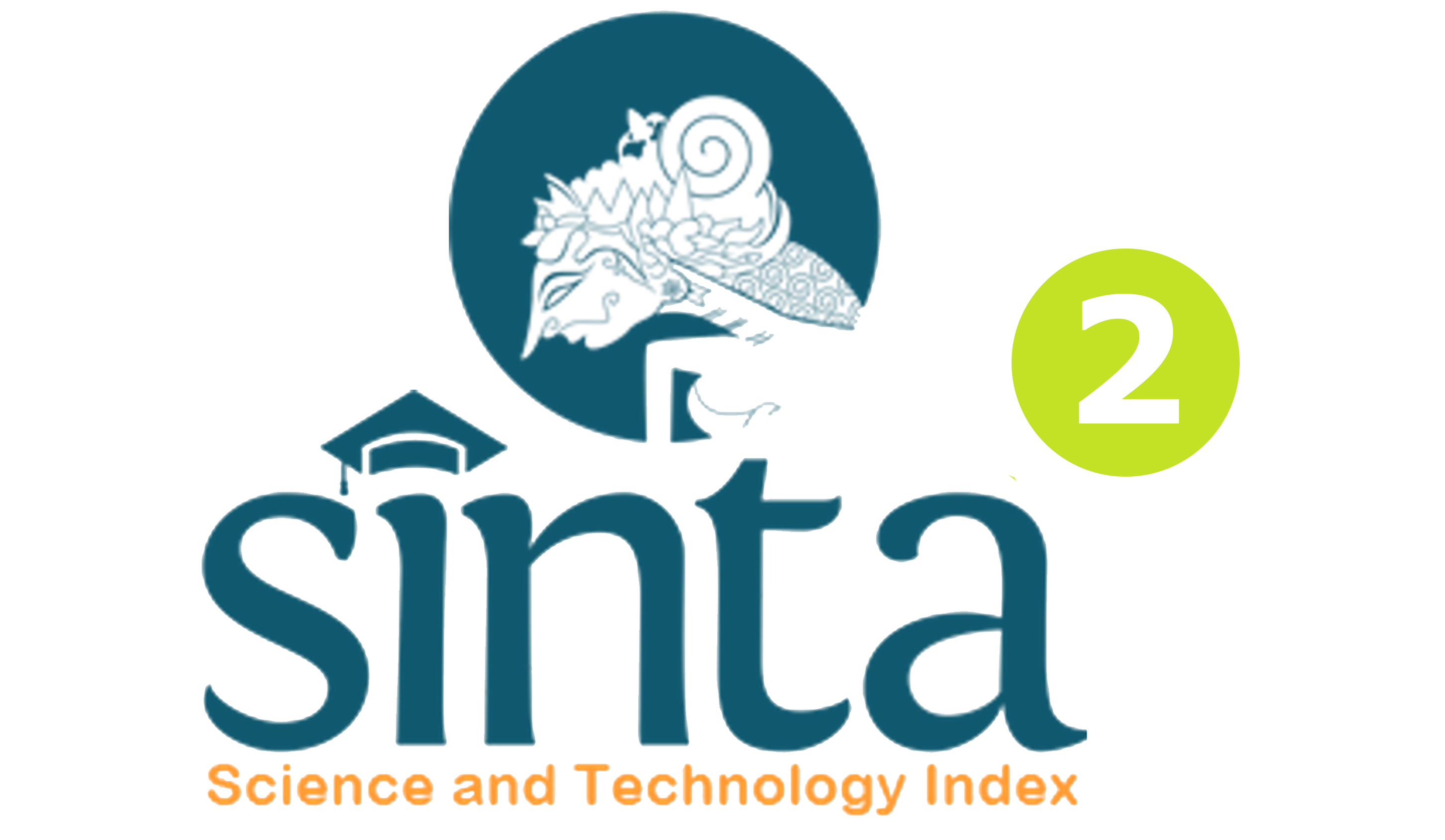Cognitive Counseling Behavioral with Modeling The Figure of Dharmawangsa to Increase Verbal
DOI:
https://doi.org/10.23887/128232017Keywords:
the ability of verbal siswa, model of cognitive counseling, behavioral modeling techniques the figure of dharmawangsaAbstract
This research aims to know the influence of behavioral counselingModeling techniquesDharmawangsa figure to improve verbal through lesson study on grade XII HIGH SCHOOL Language Lab Undiksha.This type of research is Research experiment pseudo ("Quasi alphabets experiment"). The population of this research was a HIGH SCHOOL Language class XII students of the laboratory Undiksha. Sampling techniques using a purposive sampling so that the retrieved 6 students who have low verbal ability as a group of 6 persons and more experiments as a control group. The Data collected with verbal ability tests of verbal ability.Methods of analysisthe test used wasthe t-test.Results of the study indicate that there is the influence of cognitive behavioral counseling with techniques of modeling the figure against the verbal ability of Dharmawangsa through lesson study.References
Dantes, Nyoman. (2012). Metode Penelitian. Yogyakarta : CV Andi Offset.
Dharsana, Ketut. (2013). Modul Teori-Teori Konseling. Singaraja: Jurusan Bimbingan Konseling, FIP UNDIKSHA
Dharsana, Ketut. (2014). Teori-Teori Konseling dan Teknik Konseling. Singaraja: BK FIP Undiksha.
Dharsana, Ketut. (2015). RPBK Seri 1 Bimbingan Klasikal, Bimbingan Kelompok,KonselingKelompok, Konseling Individu Untuk Pengembangan Variabel Terikat Bakat Verbal. Singaraja: BK FIP Undiksha.
Komalasari, dkk. (2014). Teori dan Teknik Konseling. Jakarta : PT Indeks
Sukardi, Dewa Ketu t& Desak P.E. Nila Kusmawati. (2009). Analisis Tes Psikologis Teori dan Praktik. Jakarta: PT RinekaCipta
Andrew Smyth, by W., Masri, S. F., Kosmatopoulos, E. B., Chassiakos, A. G., Caughey, T. K., & Hysteretic, A. I. (2004). Development of Adaptive Modeling Techniques for Nonlinear Hysteretic Systems. International Journal of Nonlinear Mechanics International Journal of Non-Linear Mechanics, 21(8), 1435–1451. https://doi.org/10.1016/S0020-7462(02)00031-8
Bronwyn Morgan, Murray Maybery, and K. D. (2003). Weak Central Coherence, Poor Joint Attention, and Low Verbal Ability: Independent Deficits in Early Autism. Developmental Psychology, 39. Retrieved from https://www.researchgate.net/publication/10663388_Weak_Central_Coherence_Poor_Joint_Attention_and_Low_Verbal_Ability_Independent_Deficits_in_Early_Autism
Chen, S. F., & Goodman, J. (1996). An Empirical Study of Smoothing Techniques for Language Modeling. Retrieved from https://arxiv.org/pdf/cmp-lg/9606011.pdf
Cheryl E. Sanders, David Lubinski, and C. P. B. (1995). Does the Defining Issues Test Measure Psychologic Phenomena Distinct From Verbal Ability?: An Examination of Lykken’s Query, 69, 498–504. Retrieved from https://www.researchgate.net/profile/David_Lubinski/publication/232563257_Does_the_Defining_Issues_Test_Measure_Psychological_Phenomena_Distinct_From_Verbal_Ability_An_Examination_of_Lykken’s_Query/links/548feb360cf225bf66a806db/Does-the-Defining-Issues-T
Cuevas, H. M., Fiore, S. M., & Oser, R. L. (2002). Scaffolding cognitive and metacognitive processes in low verbal ability learners: Use of diagrams in computer-based training environments. Instructional Science, 30, 433–464. Retrieved from http://www.speakeasydesigns.com/SDSU/student/SAGE/compsprep/Diagrams_in_CBT.pdf
Damayanti, R., & Aeni, T. (2016). Efektivitas Konseling Behavioral dengan Teknik Modeling untuk mengatasi Perilaku Agresif pada Peserta Didik Kelas VIII B SMP Negeri 07 Bandar Lampung. Konseli: Jurnal Bimbingan Dan Konseling (E-Journal), 3(1), 1–10. Retrieved from http://ejournal.radenintan.ac.id/index.php/konseli/article/view/572
Dinsmore, S. J., White, G. C., & Knopf, F. L. (2002). Advanced Techniques for Modeling Avian Nest Survival. Ecology, 83(12), 3476–3488. Retrieved from http://links.jstor.org/sici?sici=0012-9658%28200212%2983%3A12%3C3476%3AATFMAN%3E2.0.CO%3B2-P
Ehrenberg, R. G., & Brewer, D. J. (1993). Did Teachers’ Race and Verbal Ability Matter in the 1960’ s? Coleman Revisited. Retrieved from http://digitalcommons.ilr.cornell.edu/articles
Elizabeth V Gifford, K. S., Follette, V. M., Haves, S. C., Wilson, K. G., & Gifford, E. V. (1996). Experiential Avoidance and Behavioral Disorders: A Functional Dimensional Approach to Diagnosis and Treatment. Journal of Consulting and Clinical Psychology Copyright, 64(6), 1152–1168. Retrieved from https://thehappinesstrap.com/upimages/experiential_avoidance.pdf
Ersal, T., Fathy, H. K., Louca, L. S., Rideout, D. G., & Stein, J. L. (2007). A Review of Proper Modeling Techniques. Retrieved from http://www-personal.umich.edu/~tersal/papers/paper5.pdf
Hasher, L., & Zacks, R. T. (1988). Working Memory, Comprehension, and Aging: A Review and a New View. Psychology of Learning and Motivation - Advances in Research and Theory. https://doi.org/10.1016/S0079-7421(08)60041-9
Larson, C. O., Dansereau, D. F., O ’donnell, A., Hythecker, V., Lambiotte, J. G., & Rocklin, T. R. (1984). Verbal Ability and Cooperative Learning: Transfer of Effects. Journal of Reading Behavior, XVI(4). Retrieved from http://journals.sagepub.com/doi/pdf/10.1080/10862968409547522
Linehan, M. M., Armstrong, H. E., Suarez, A., Allmon, D., & Heard, H. L. (1991). Cognitive-Behavioral Treatment of Chronically Parasuicidal Borderline Patients. Archives of General Psychiatry, 48(12), 1060. https://doi.org/10.1001/archpsyc.1991.01810360024003
Mackenzie, S. B., Podsakoff, P. M., & Podsakoff, N. P. (2011). Construct Measurement and Validation Procedures in Mis and Behavioral Research: Integrating New And Existing Techniques. MIS Quarterly, 35(2), 293–334. Retrieved from https://temme.wiwi.uni-wuppertal.de/fileadmin/_migrated/content_uploads/mackenzie_podsakoff_podsakoff_2011_01.pdf
Mischel, J. W. (1973). Toward a Cognitive Social Learning Reconceptualization of Personality. Psychological Review, 80(4), 252–283. Retrieved from http://psych.colorado.edu/~carey/Courses/PSYC5112/Readings/psnSituation_Mischel01.pdf
Näslund, J. C., & Schneider, W. (1991). Longitudinal Effects of Verbal Ability, Memory Capacity, and Phonological Awareness on Reading Performance. Europeon Journal of Psychology of Educalion, 4, 375–392. Retrieved from https://opus.bibliothek.uni-wuerzburg.de/opus4-wuerzburg/frontdoor/deliver/index/docId/7204/file/Schneider_W_OPUS_7204.pdf
Peter Bryant, Jane Oakhill, K. C. (2004). Children’s Reading Comprehension Ability: Concurrent Prediction by Working Memory, Verbal Ability, and Component Skil. Journal of Educational Psychology, 96. Retrieved from https://www.researchgate.net/profile/Kate_Cain/publication/228727270_Children’s_Reading_Comprehension_Ability_Concurrent_Prediction_by_Working_Memory_Verbal_Ability_and_Component_Skills/links/09e4150a2c93bb8ad4000000.pdf
Rapee, R. M., & Heimberg, R. G. (1997). A Cognitive-Behavioral Model of Anxiety in Social Phobia. Behav. Res. Ther, 35(8), 741–756. Retrieved from https://pdfs.semanticscholar.org/b340/9ea9e4d68c1f37d408ceb27be3656d43c57e.pdf
Stephenson, M. T., & Holbert, R. L. (2003). A Monte Carlo Simulation of Observable Versus Latent Variable Structural Equation Modeling Techniques. https://doi.org/10.1177/0093650203252410
Susan Brady, Donald Shakweiler, V. M. (1983). Speech Perception and Memory Coding In Relation to Reading Ability. Journal of Experimental Child Psychologi, 35, 345–367. Retrieved from http://www.haskins.yale.edu/Reprints/HL0405.pdf
Thomaswhogaboam and Jameswpellegrino. (1978). Hunting for individual differences in cognitive processes: Verbal ability and semantic processing of pictures and words. Memory & Cognition, 6(2), 189–193. https://doi.org/10.3758/BF03197445









